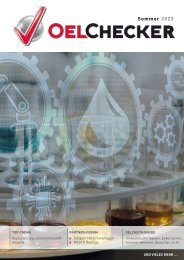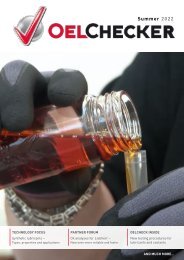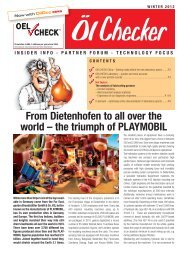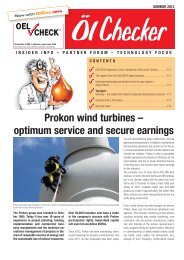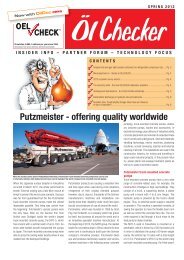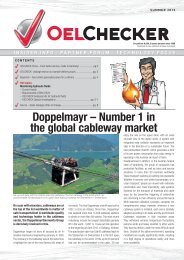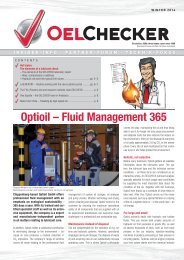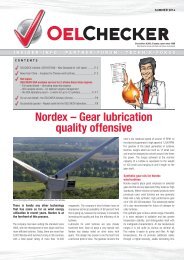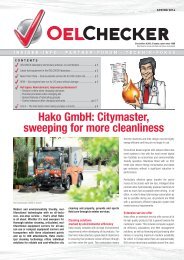OELCHECKER Winter 2022 - English
> HOT TOPIC: Condition-based oil changes – save money and protect the environment > OELCHECK INSIDE: 2022 UN Climate Change Conference / GfT honours Peter Weismann / High-level visit from the USA > TECHNOLOGY: Focus AdBlue – A cleaning agent with no residual alcohol > OELCHECK INSIDE – ALL ANALYSES FROM A SINGLE SOURCE AdBlue – New all-inclusive analysis kits Fuels – Investigations pursuant to DIN now available for almost all types Coolants – New Ultra analysis kit for faults in the cooling system > OELCHECK PARTNER FORUM: Bayerische Regiobahn – Climate- and environmentally friendly travel > FAQ: The tribologists at OELCHECK – Their knowledge and tasks > OilDoc News: OilDoc Conference & Exhibition / Seminar highlights
> HOT TOPIC: Condition-based oil changes – save money and protect the environment
> OELCHECK INSIDE: 2022 UN Climate Change Conference / GfT honours Peter Weismann /
High-level visit from the USA
> TECHNOLOGY: Focus AdBlue – A cleaning agent with no residual alcohol
> OELCHECK INSIDE – ALL ANALYSES FROM A SINGLE SOURCE
AdBlue – New all-inclusive analysis kits
Fuels – Investigations pursuant to DIN now available for almost all types
Coolants – New Ultra analysis kit for faults in the cooling system
> OELCHECK PARTNER FORUM: Bayerische Regiobahn – Climate- and environmentally friendly travel
> FAQ: The tribologists at OELCHECK – Their knowledge and tasks
> OilDoc News: OilDoc Conference & Exhibition / Seminar highlights
You also want an ePaper? Increase the reach of your titles
YUMPU automatically turns print PDFs into web optimized ePapers that Google loves.
TECHNOLOGY FOCUS<br />
ADBLUE<br />
A CLEANING AGENT WITH NO RESIDUAL ALCOHOL<br />
© Adobe Stock<br />
It goes without saying that the idea of 32.5% urea in one litre of fluid doesn’t sound appealing. AdBlue is produced<br />
purely industrially while human urine, on the other hand, is anything but clean. It contains 3-4% urea,<br />
protein, other impurities – and often, residual alcohol, too.<br />
Lower emissions and lower diesel consumption<br />
Characteristics at a glance<br />
© Adobe Stock<br />
However, it was precisely because of the sanitary connotations that<br />
the name AdBlue came into being. In principle, the name AdGreen<br />
would be a better description for the role of the concentrate. After<br />
all, AdBlue is key to reducing NOx emissions in the commercial vehicle<br />
sector and in diesel cars.<br />
The urea injected into the exhaust dissolves into ammonia and very small<br />
quantities of carbon dioxide (CO 2<br />
) in the hot exhaust gas. The ammonia<br />
forms a compound with nitrogen oxides in the catalytic converter when<br />
exposed to heat. This produces nitrogen and water vapour, both natural<br />
components of the atmosphere and therefore completely harmless in the<br />
exhaust gas. This reaction is known as selective catalytic reduction (SCR).<br />
For vehicles, the urea solution is the storage or transport form for ammonia,<br />
which can also be used directly to reduce NOx in the SCR catalytic<br />
converter in stationary systems.<br />
Using this technology offers a way to reduce pollutants in diesel engines,<br />
which ’suffer’ from the NOx particle trade-off due to combustion.<br />
Depending on the design, the engine generates either more NOx<br />
and fewer tiny soot (particles), or less NOx and more soot (particles).<br />
Both require an effective after-treatment process for exhaust gases.<br />
While the requirements of the Euro 5 emissions standard could still<br />
be fulfilled using internal engine measures (such as recirculating exhaust<br />
gases) and a diesel particulate filter, the emissions standard<br />
requires the use of an SCR system with AdBlue from Euro 6 onwards.<br />
Using an SCR system with AdBlue means that engines can be used<br />
differently, the soot quantity can be reduced over the entire operating<br />
range, the load points can be improved and, in addition to reducing<br />
NOx, fuel savings of up to 6 % can be achieved.<br />
This technology reduces the nitrogen oxides in the diesel exhaust<br />
gases emitted by commercial vehicles by 85 % for Euro 5 and by<br />
95-98 % for Euro 6 – and that’s all down to an AdBlue system. If a<br />
vehicle is equipped with such a system, however, it won’t run without<br />
AdBlue, as the engine won’t start if AdBlue is not present. And<br />
there is also a fiscal reason for this, too, as incorrect exhaust gas<br />
after-treatment would constitute tax evasion.<br />
AdBlue is a registered trademark of the German Association of the<br />
Automobile Industry (VDA (Verband der Automobilindustrie e.V.)).<br />
Outside Germany, designations such as DEF (Diesel Exhaust Fluid)<br />
and AUS 32 (Aqueous Urea Solution) are also used.<br />
The quality requirements for the product are set out in ISO Standard<br />
22241-1. The pure urea content must be 32.5%. A higher concentration<br />
of 40 % (AUS 40) is required pursuant to ISO Standard 18611 for<br />
use in the large engine sector (marine or engine power plants).<br />
Substances other than pure water and dyes are not permitted in Ad-<br />
Blue. Elements such as calcium and aluminium may only be present<br />
in very small traces. Under no circumstances may AdBlue be contaminated<br />
with non-ferrous metals such as zinc, copper or nickel,<br />
or elements such as sulphur, sodium or potassium. SCR catalytic<br />
converters are sensitive to what are known as catalyst poisons, and<br />
contaminated AdBlue significantly reduces a catalytic converter’s<br />
service life.<br />
The transparent liquid is non-flammable and non-toxic, but may irritate<br />
the eyes, skin and respiratory tract. You should therefore rinse<br />
your skin under plenty of water if it comes into contact with AdBlue.<br />
Furthermore, AdBlue is corrosive to steel, iron, nickel and non-ferrous<br />
metals, while paints and plastics can be damaged by prolonged<br />
exposure.<br />
Shelf life and storage<br />
AdBlue’s shelf life depends primarily on the temperature and the<br />
circumstances in which it is stored. AdBlue can be stored for around<br />
18 months at a storage temperature of -5 °C to +25 °C. It should be<br />
noted, however, that prolonged storage above 25 °C may cause the<br />
urea to decompose. If AdBlue is stored at temperatures above 30 °C,<br />
its shelf life is significantly reduced.<br />
The following apply as a general rule of thumb: The storage stability<br />
decreases by six months for every 5 °C over 30 °C. If the product is<br />
still used at some point, this may result in damage to the catalytic<br />
converter system and the engine.<br />
AdBlue freezes from -11 °C, but can be used once it has thawed out.<br />
A word of caution, though: AdBlue expands like water in frosty conditions<br />
and may cause containers to burst.<br />
Demand for AdBlue has soared to extreme levels. Whereas a diesel<br />
car consumes only 1.5 to 2.8 litres every 1,000 kilometres, a commercial<br />
vehicle requires around 5 % – and large engines even up<br />
to 10% – of the diesel requirement in AdBlue. This equates to an<br />
estimated total consumption of AdBlue of between 2.5 and 5 million<br />
litres per day in Germany alone.<br />
In principle, AdBlue should be kept out of direct sunlight and not<br />
stored at extreme temperatures. The containers must be well<br />
sealed to prevent dirt from penetrating and prevent the product<br />
from concentrating due to evaporation.<br />
7




